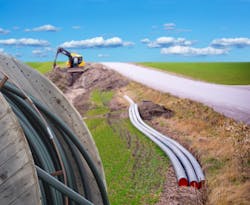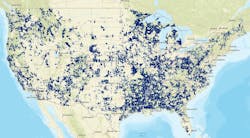By Ellie Coggins, Associate Editor
Over the next few months, the editors of Electrical Wholesaling will continue to break down what Biden’s infrastructure plan will mean for electrical distributors and the overall industry. Last issue, we covered the impact of the electrical vehicle (EV) and EV charging infrastructure portion of the plan. This month, we’ll be revealing the challenges and opportunities behind widespread broadband expansion, valuable resources and more.
On July 9, President Biden signed onto a bipartisan infrastructure deal with a group of senators, which plans to provide about $579 billion in new investments toward many – but not all – of the goals laid out in Biden’s original infrastructure proposals, according to The New York Times report. Build-out of broadband infrastructure remained in this version, with $65 billion designated toward Biden’s goal to provide universal broadband. The Federal Communications Commission (FCC) set a policy in 2015 declaring the minimum broadband standard as 25 Megabits per second (Mbps) download and 3 Mbps upload, which is still active today. However, several senators are calling for a new standard of 100 Mbps for both uploads and downloads, according to an Engadget report, to meet greater broadband needs as a result of the pandemic.
According to the original White House Fact Sheet on the plan, more than 30 million Americans live in areas where there is no broadband infrastructure to meet needs such as work, education, health care and more. Many rural and low-income urban communities face the most challenges. This means ample opportunity for those in the electrical industry, including distributors, manufacturers and manufacturers’ reps to take advantage of this business opportunity.
Opportunities abound. In our 2021 Top 150 survey, sixteen distributors reported that the broadband potion of Biden’s plan would have a “major impact” on their business. Graybar, #3 on this year’s Top 150 rankings, is already a big player in this vertical and for some times has worked with electric cooperatives to help provide broadband to underserved areas.
David Eckell, Graybar’s national market manager & emerging technologies, says opportunities will exist for electrical distributors to provide in-demand products. “We provide a full suite of electrical and data communications products that support high-speed internet deployments, from optical fiber and electronics to electrical distribution components needed to power the solutions,” he said. Of these products, Eckell says market demand will be highest for outdoor fiber-optic cable.
Other distributors are also preparing for the influx of business opportunities presented by high-speed broadband expansion, including WESCO, ranked #1 on this year’s Top 150 list due to its acquisition of Anixter, which nearly doubled its size. Although it has always had a strong foothold in the voice/data/video (VDV) market, this acquisition certainly positions WESCO to expand in several key markets, including high-speed broadband expansion.
According to a transcription posted by the Motley Fool of the most recent WESCO earnings call with investment analysts, John Engel, chairman, president and CEO, said the company’s broadband business was up double digits over the previous year, “driven by strong demand for data and high-speed connectivity that has never been greater due to the step change expansion in remote connectivity for work-from-home and school-from-home applications.
“Additionally, we are seeing early benefits from our participation in the federal government's Rural Digital Opportunity Fund Project, a $20-billion investment to bring high-speed broadband service to rural homes and businesses. Phase one of that project began at the end of last year,” he added.
Distributors could see business opportunities by partnering with electric co-ops, like Graybar has. According to an April 16 report from the National Rural Electric Cooperative Association (NRECA), these cooperatives power 56% of the nation’s landmass and more than 200 co-ops are currently developing or planning to deploy broadband service to their members. See the Sidebar for more information on electric co-ops and other resources with valuable information as the federal government gets closer to making a deal on the infrastructure plan.
A few roadblocks. While we expect there to be tough competition in this vertical within the electrical industry, there is an extra challenge that distributors and others in the electrical industry must be aware of -- big telecom companies, which have traditionally tried to control broadband expansion and limit competition. However, Biden’s plan could potentially lead to a broadband law aiming “to increase competition in broadband markets by preempting state and local laws prohibiting nontraditional players such as electrical co-ops from selling broadband service,” according to a Fast Company report.
Eckell said that this is a common challenge Graybar’s customers have had to overcome, especially in rural areas. “Unfortunately, many customers are at the mercy of the local providers that offer connectivity,” he said.
Other challenges exist for rural customers. Eckell cited remote connectivity as a potential issue that wireless solutions can help solve. “Sometimes there are distance and line-of-sight limitations that make this application difficult to apply broadly,” he said.
Another challenge the overall industry will inevitably face will be product and labor shortages because of the pandemic. Eckell said outdoor fiber-optic cable and related products could in high demand and have extended lead times because of broadband expansion, as manufacturers recover from last year’s COVID slow-down. “Coupled with the labor shortage, these challenges mean customers will likely have to plan their projects in an unconventional way, making it hard to predict which products will be most in-demand at any given time,” he said.
In conclusion. Overall, participation in this market may have unexpected challenges from telecom and local internet providers and fierce competition from big electrical distributors like Graybar and WESCO with existing footholds in this vertical. However, with an anticipated $65 billion in federal dollars being designated for broadband expansion, it’s a market ripe with potential for the electrical industry, especially if the White House passes laws that increase competition within the broadband market and allow electric co-ops to play a more substantial role in rural areas.
Based on the latest news from the White House, we anticipate broadband to play a big role in whatever iteration of the infrastructure plan is passed. And for millions of Americans, this will mean better, faster and easier connection to the world.
“In a general sense, when local communities gain access to high-speed internet, they can take advantage of global resources that enhance the lives of their citizens, such as access to educational resources, health-care technology and new business opportunities,” Eckell said. “This bill will help even the playing field and open up a host of new opportunities.”
SIDEBAR: WHERE TO GO FOR MORE INFORMATION
Distributors and others in the electrical market will need to be aware of some of the complex competitive challenges facing the broadband portion of the infrastructure plan. As the plan comes closer to a bipartisan agreement, it seems to be changing on a near daily basis. Staying up to date on these changes will be key for distributors, reps and manufacturers that want a piece of high-speed broadband expansion. Here are a few good sources of information to check out.
• National Rural Electric Cooperative Association (NRECA). The NRECA is composed of nearly 900 cooperatives that serve to provide energy and spur economic development for more than 20 million American homes, businesses, farms and schools in 48 states, according to its latest report.
• The Federal Communications Commission (FCC). According to its website, the FCC regulates interstate and international communications by radio, television, wire, satellite and cable in all 50 states, Washington DC and U.S. territories. Part of its role involves promoting competition and innovation in the broadband sector.
• U.S. Chamber of Commerce. On June 22, the organization outlined a series of points it would like to see Congress accomplish in terms of broadband, including embracing public-private partnerships to deploy broadband; addressing connectivity affordability; and modernizing federal, state and local government IT systems. See the full letter here.

